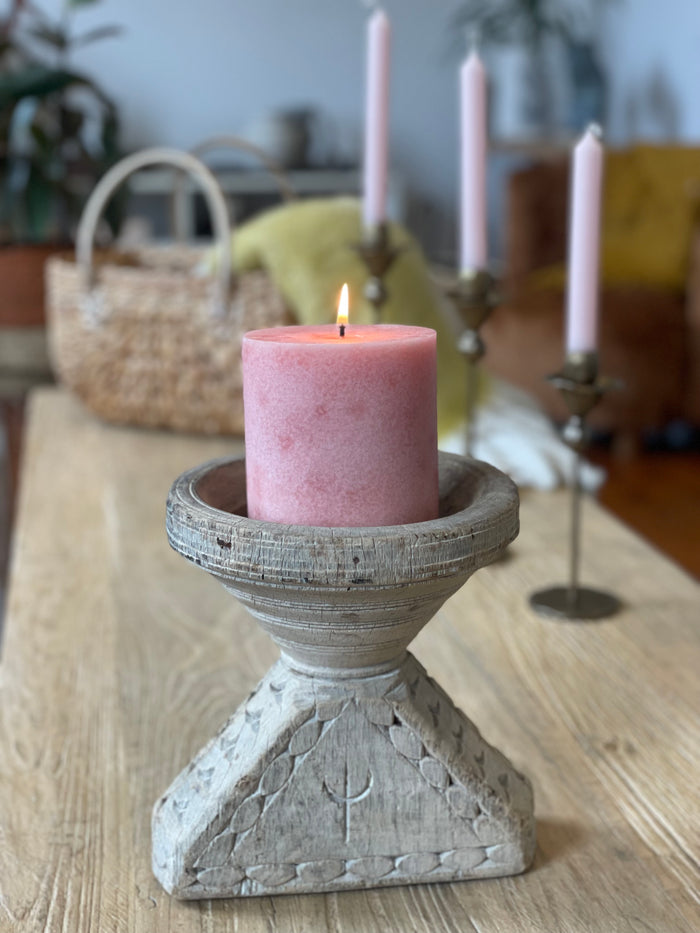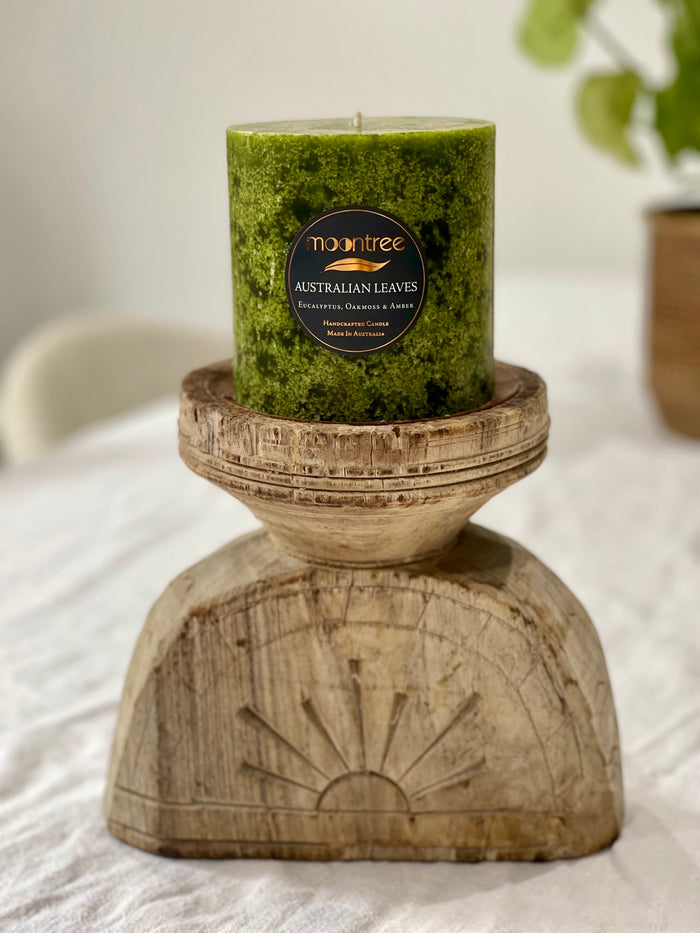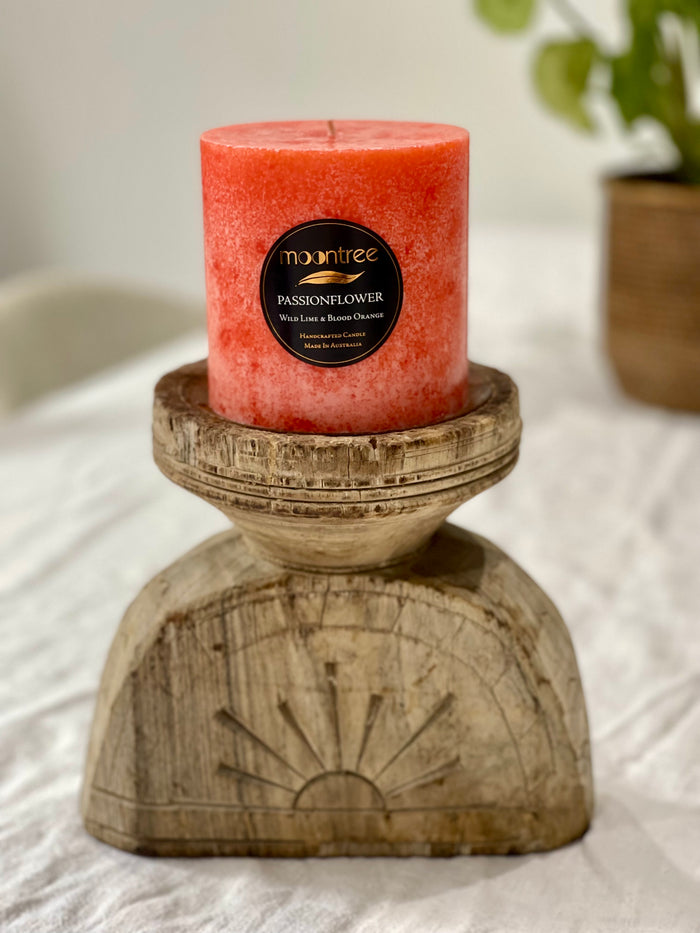Moontree is located in the Blue Mountains within the Country of the Dharug and Gundungurra peoples.
We acknowledge their continuous and deep connection to their Country.
General Candle Care
- Trim wick to 6mm before lighting
- Place burning candles 10cm apart
- Avoid drafts to prevent drip & smoke
- Use a heat-proof non-flammable base
- Don’t burn a candle all the way down
Follow the above guidelines and you should be well on your way to enjoying your candlelit evenings and events. If you have any feedback or further questions, please get in touch.


Container Candles
- On your first burn, light your candle for at least three hours. This will allow an even melt across the surface of the candle and will avoid tunnelling. Tunnelling results in a ‘tunnel’ effect running down the centre of your candle.
- To finish your burn, simply extinguish the flame by blowing gently or using a candle extinguisher, or by using the lid to extinguish the flame. This prevents any chance of the melted wax from spilling.
- Before or after use, always trim the wick of your candle to a length of 5mm. This will stop the flame from becoming too big and will give you a smoke-free and even burn.
- Looking after your wick is essential and will pro-long the life of your candle. Our Wick Trimmer is the perfect accessory and have been designed to cleanly cut your wick every time.
- Discontinue use of your candle once wax is 10mm from the bottom. This will prevent any heat damage and cracking of glass.
- Always burn your candle on a flat and stable surface.
Pillar Candles
Always place your candle on a heat resistant base whether lit or unlit to avoid scorching and or colour leaching.
Initial burn time
Let the wax melt close to the edge the first time you burn your candle. This may take up to 6 hours of burning, depending on the diameter of the candle (see below under 'Setting the memory' for details, or check out our Getting Started guide), so make sure you allow for enough time before you light your candle for the first time.
This is because the size of the wax pool during the first burn determines the life of the candle. Subsequent burns won't melt the wax beyond the initial wax pool, so if it didn't melt close enough to the edge of the candle, it could leave a thick, unused mantle ('tunnelling').
Setting the memory
To avoid this tunnelling effect we need to maximise the size of the initial wax pool. This is called setting the memory of the candle, and it is done by burning the candle for 1 hour per 2cm in diameter the first time you light it. For our 7cm diameter pillar candles, the initial burn time should be 3-4 hours, and for our 10cm diameter textured column candles it should be at least 5 hours. Due to their unique shape, our cone candles do not have such a requirement.

Common Issues

Tunnelling
When a candle burns hollow, or leaves a thick, unused mantle or rim, this is referred to as 'tunnelling'. Tunnelling has some negative effects: if tunnelling continues unchecked, you'll end up throwing away a large part of your candle, as the rim won't melt away. A tunnelling candle will also smoke, as the tunnel disrupts the airflow to and from the flame.
It can be avoided by making sure the initial burn is long enough to melt the candle all the way to the edge, or in other words; to maximise the wax pool. See above for details of this process, which is referred to as setting the memory of the candle. As a rule of thumb, burn your pillar candle for 1 hour per 2cm in diameter the first time you light it.
If the tunnelling hasn't gone too far, try allowing the candle to sort itself out by burning it for a prolonged period of time; anywhere from 4 to 8 hours could do the trick. If that doesn't help, another way to fix it is by 'hugging' the candle; pushing the soft wax rim at the top of the candle inwards towards the flame, so that it has a chance to melt.
If however the tunnelling has gone too deep to fix by hugging, the rim can be trimmed down with a sharp knife when the wax is warm. Blow out your candle, make sure the wax pool solidifies or clean it out to avoid dripping wax everywhere, and cut off the excess rim. Be careful not to damage the rim or the candle might start dripping when you relight it.
Note that a single-wick candle with a diameter greater than 10cm will generally tunnel, as the wick won't generate enough heat to melt the wax all the way to the edge.

Smoking
A well-made candle can produce a little smoke every now and then, but it should never continuously smoke. If your candle flame keeps flickering, it might also be smoking. If a noticeable amount of smoke is being generated, or the sides of your container show black marks, knowing the causes can help stop it.
Keep your wax pure
It is a common misconception that sooting is caused by the type of wax (e.g. beeswax, coconut, palm, paraffin or soy wax), but sooting is primarily due to flame and combustion disturbances1. Contrary to popular belief, the wax type has little to do with whether a candle smokes or not, but what is important is the purity of the wax that is used. Any impurities mixed into the wax, including scent oils3, can impair combustion conditions and cause smoking2. Always choose candles with high-purity wax, and make sure the wax pool is free of any debris.
The most common culprit for a smoking candle is a flame disturbance, which itself can have multiple causes, as outlined below.
Move away from draught If a candle is exposed to a draught, vent or air current, the flame will start flickering and it will likely smoke. To avoid this, move the candle out of the draught or shield the flame from the draught.
Keep the wick trimmed
A wick that is too long won't be able to draw wax all the way to the top, and the wick itself will start to burn, causing it to smoke. A wick that is too long can also cause a candle flame to grow too long and flare, again producing smoke. If the wick has gotten too long, extinguish the flame, let the candle cool down, trim the wick to 6mm (1/4 inch) and light again.
Avoid tunnelling
A tunnelling candle will usually smoke, as the tunnel disrupts the airflow to and from the flame, similar to a container that is too small - the next paragraph explains how this works. To prevent or fix tunnelling, read our tips here.
Choose the right container
If your smoking candle is inside a candle jar, vase, lantern or container, then it could be that the vase is too small for the candle. As the oxygen inside the container burns up, more air is sucked into the container from the top, yet at the same time warm air, heated by the candle, is rising up and trying to escape the container. These two flows or air disrupt each other, causing a draught inside the container that disturbs the flame. You can often see the results of a soot-producing candle on the rim of your jar in the form of a black ring.
To avoid this, choose a bigger container and/or smaller candle: make sure that there is enough space between the candle and the vase edge. As a rule of thumb, ideally you should be able to insert two fingers between the candle and the edge of the container.

Don't Blow It
Last but not least is the process of extinguishing the candle. The greatest amount of sooting from a candle generally occurs when the flame is extinguished. One of the cleanest ways to do it is to dip the wick: extinguish your candle by pushing the wick into the pool of hot wax and pulling it back out.
Any candle that continually flickers or smokes is not burning properly and should be extinguished and allowed to cool. The wick can then be trimmed, the wax pool checked for any debris and the candle relit after ensuring that the area is free of draughts.

Dripping
A dripping candle can have a number of causes. Fortunately, if you're burning a well-made, good quality candle then all these issues can be easily remedied; it's just a matter of determining the cause and knowing the solution. So let's have a look at how to keep pillar candles from dripping.
Keep away from draughts
A strong draught can cause molten wax from the wax pool to get blown over the sides of the candle. Eliminate the source of the draught, move the candle out of the draught or shield the candle from the draught.
Not too close
If the candle is too close to other candles, this can cause irregular melting and warping. Place lit candles at least 10cm apart to avoid melting and warping due to heat from neighbouring candles. It could also be that your candle has been placed at an angle - make sure the candle is standing up straight.
Check your container
Placing a candle or multiple candles inside a vase or container looks great, but due to the heat build up (the heat cannot escape as easily & the container walls reflect heat back to the candle) it could melt the rim of the candle and lead to dripping. Solutions are to use a larger container (we recommend leaving at least ~2cm between the candle and the edge of the vase), placing less candles inside the container, burning the candle for shorter periods of time or to pre-tunnel the candle: rather than burning to the edge, create a thick rim (see above regarding tunnelling) which is less easy to melt down inside the container.
Our 7cm diameter pillar candles have been tested not to drip in cylinders from 10cm diameter upwards, so keep this in mind when choosing your vase.
Burn time
When you first light your candle, burn your candle for at least 3 hours; you want the wax pool to reach the edge of the candle to avoid tunnelling, but you don't want to melt through the mantle. As a rule of thumb, burn your candle for 1 hour per 2cm in diameter the first time you light it. After the first burn, avoid burning your candle for longer than 4 hours; extinguish, let the candle cool down, trim the wick, and relight.
Don't let the wick get too long
If you notice your candle (might start) dripping, check the wick; it could be that the wick is too long, causing a large, flickering and unstable flame. Extinguish the flame, let the candle cool, trim the wick down to 6mm and relight.
As you see, most of the causes of dripping can be easily fixed and avoided, and if they cannot then it's more likely a symptom of a poor quality candle (low quality wax, incorrect wick size or positioning, poor make quality) rather than incorrect use of the candle.
How to extinguish a candle
When the time comes to extinguish your candle, you could do better than blowing it out. Instead of filling your room with smoke and potentially splashing wax everywhere, dip the wick: extinguish your candle by pushing the wick into the pool of hot wax and pulling it back out. Use a specially designed wick dipper or any suitable non-flammable tool (we use a BBQ skewer!). Dipping the wick eliminates wick smouldering and smoking. Added bonus: the wick gets coated in wax and is primed for the next lighting.
Coastal Garden
- Regular Price
- from $12.95
- Sale Price
- from $12.95
- Regular Price
-
- Unit Price
- per
Aqua Luna
- Regular Price
- from $12.95
- Sale Price
- from $12.95
- Regular Price
-
$0.00
- Unit Price
- per
Australian Leaves
- Regular Price
- from $12.95
- Sale Price
- from $12.95
- Regular Price
-
$0.00
- Unit Price
- per
Elixir
- Regular Price
- from $12.95
- Sale Price
- from $12.95
- Regular Price
-
$0.00
- Unit Price
- per
Fireside
- Regular Price
- from $12.95
- Sale Price
- from $12.95
- Regular Price
-
$0.00
- Unit Price
- per
Lemongrass
- Regular Price
- from $12.95
- Sale Price
- from $12.95
- Regular Price
-
$0.00
- Unit Price
- per
Lotus Temple
- Regular Price
- from $12.95
- Sale Price
- from $12.95
- Regular Price
-
$0.00
- Unit Price
- per
Native Garden
- Regular Price
- from $12.95
- Sale Price
- from $12.95
- Regular Price
-
$0.00
- Unit Price
- per
Passion Flower
- Regular Price
- from $12.95
- Sale Price
- from $12.95
- Regular Price
-
$0.00
- Unit Price
- per
Persian Nights
- Regular Price
- from $12.95
- Sale Price
- from $12.95
- Regular Price
-
$0.00
- Unit Price
- per
Sandalwood
- Regular Price
- from $12.95
- Sale Price
- from $12.95
- Regular Price
-
$0.00
- Unit Price
- per
Sweet Love
- Regular Price
- from $12.95
- Sale Price
- from $12.95
- Regular Price
-
$0.00
- Unit Price
- per

























